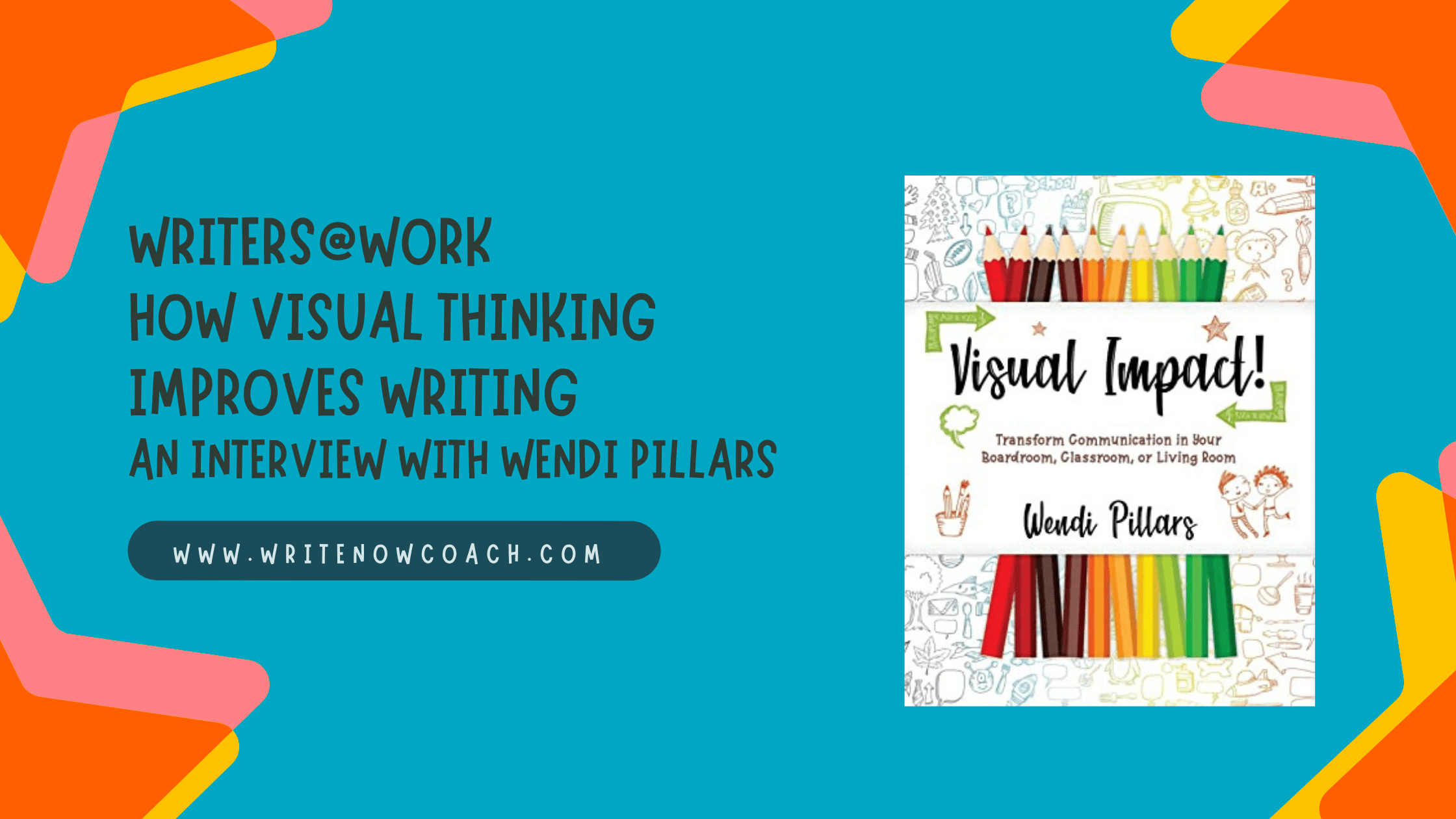How Visual Thinking Improves Writing
May 3, 2022
Note From Rochelle
Dear Writers,
This past weekend, I saw Carol Burnett perform live. She was one of my childhood heroes, and it was a delight to hear her stories.
She told a story that helped me—and it may help you. She once auditioned for a part, and it came down to her and another girl. When she didn’t get the part, she was disappointed. But she told herself, “You know what? It’s her turn. It’s not my turn. It’s her turn.” I wasn’t discouraged because I figured, ‘OK, my turn will come sooner or later.’ And it did.” (https://www.palmspringslife.com/carol-burnett/) I thought that was a brilliant take on a challenging situation. As writers, we get rejected a lot. It can help to remind ourselves that our turn will come.
For today’s tip, I interview Wendi Pillars about her book Visual Impact. Learn how she uses visual thinking to help her record and develop ideas.
Happy writing,
Rochelle, the Write Now! Coach
Writers@Work: How Visual Thinking Improves Writing
An Interview with Wendi Pillars
By Rochelle Melander
Welcome, Wendi. Can you tell us about your new book?
Hi and thank you! Visual Impact: Transform Communication in Your Boardroom, Classroom, or Living Room, is a book I wrote for anyone who wants to communicate more clearly with someone else. Maybe you’re a corporate executive who assumes everyone understands your vision, a parent who wants to help their child organize their day, or you’re an informal or formal educator who wants to make learning stick just a little bit more. This book is for you!
It’s packed with practical ways to use visual thinking in your next meeting, classroom, or conversation. The coolest aspect is that for every one-page topic, there’s a full-page visual note to accompany it. You can analyze, copy, model, and figure out what you like or dislike about the pairing. What works for you? How can you apply these ideas in your own context? Every topic comes from personal experience borne from questions asked by organizations, other educators, parents, or just me trying to figure out how to improve my craft. There is something in this book for anyone who has something to communicate and has the humility to step back and explore how they can do so more effectively.
Can you talk about why visual thinking and visual notes are so powerful, even for people who cannot draw?
Imagine your day. How many times do you rely on simple icons for understanding, for knowing which public bathroom to use, for quickly clicking an app, for gauging speed on an upcoming s-curve, or for laundry instructions on your multilingual clothing tag? Visual thinking is our way of life yet our life at breakneck speed is simultaneously a cause and effect of visual efficiency. We use them all the time because they’re effective, yet we don’t give ourselves enough credit to create them.
Adults are so quick to claim an inability to draw. Not sure who said this, but if you fight for your limits, you get to keep them. I’ve worked with learners of all ages, from pre-k to adults, and success is often a matter of three things:
- Equipping people with confidence by teaching a few simple drawing tips, aka, just having permission to try
- Focusing on the thinking process by taking the abstract and putting it on paper, and
- Never judging the aesthetic quality of your work.
The HUGE takeaway is how even the simplest lines and drawings bely the complexity of thinking because they force creators to reflect and ask “Is this what I really mean?” “How can I explain this better?” “What do I really want to achieve through this process/ presentation/ project?” Drawing out your thinking also requires a deceleration–notice I didn’t say simplification–of your swirling mind. It grounds you and provides space for your (and others’!) ideas to connect, expand, and deepen. If you are listening to someone and mapping out their ideas, it centers their input which then empowers them because they feel heard.
As a professional visual strategist, I use visuals formally and publicly to capture knowledge, to share ideas, and to honor those I’m learning from and working for. As an educator, I use simple sketches to clarify topics in class or to shift speed when I feel pressured to cover insane amounts of material. Students always reflect that this helps them think better because it “slows things down” and makes it easier to understand. I also use them behind the scenes to organize thoughts for writing, to map out projects, to help others envision goals and to plan myriad activities, including weddings, road trips, student grant applications and organizational troubleshooting. I’ve even sketched a friend’s pre-surgery notes and next steps!
Obviously I walk my talk and believe in the immense power of visuals. This book was my way to share the possibilities with the world. We rely on visuals everyday, consuming them continually, yet actually generating them and thinking for ourselves is becoming a lost art. Making space for that thinking, for “making your brain hurt” is well worth the effort.

For years, I’ve used mind maps to record my ideas. How did you use visual thinking and note taking in researching and writing your book?
I think that’s wonderful! I imagine your mind maps help you expand your thinking in far different ways than if you had listed your ideas in a linear manner.
I knew from the start that I wanted to model what I’m writing about. For me, that meant creating visuals for each topic in the book. I hadn’t realized how many notes I’d compiled over the years, so when I started to decide how to organize them, I used chart paper to map out chapters. Seeing all of the information, I realized I wanted readers to have short chapters, to dip in and out of, to look at one topic and be able to use it in their context the next day.
My chapters then became 2-pagers, one page with text and the other a full-page visual. From that point, I played text and visual off of one another, sometimes visualizing first, then writing, and vice versa. Many times I thought that it would have been so much simpler to just write, but the visuals were solid anchors for my brain. As a note, I have had the imagery of this book in my mind for years, so it was satisfying to peel off those mental pages as I completed them.
Do you have any favorite tools (paper, pens, and markers) that you recommend to your readers?
I currently rely heavily on two places to capture my thinking: a sketchbook that lies flat when opened (various brands) and my 10×9 iPad Pro with the ProCreate App (paid app, but well-worth it!). To draw, I use flair pens, Fudenosuke brush pens, and an apple pencil. Sometimes I will use watercolor or pastels, but I prefer to keep it simple. When sketching for instruction I typically use a black flair pen with one or two highlight colors, and discourage students from using pencil so that they learn that mistakes aren’t the end of the world.
What are you reading now?
I’m one of those multi-book readers and I’m sure you have a few of those in your audiences! I’m still trying to keep up with research on learning, so I’m reading A History of the Human Brain; for my environmental educator side, Under a White Sky about the nature of the future; and my historical fiction fix is West With Giraffes, about two giraffes rescued in a hurricane at sea. Chances are you might find a sketch or two on Twitter with my big ideas gleaned from these reads. Creating visuals when I read sure helps me remember more, while helping others learn, too!
I challenge your readers to make just one sketch today. If you’re stuck, ask your kids how they would represent “_____”, or just start making lines with your markers and tell your story as you go. Labels and shapes will also go a long way in crafting your magic. The most important step is to just try it. What’s one visual that would represent what you read here today? Share with me on Twitter @wendi322!

 About the author. As a curiositarian and lifeaholic, Wendi Pillars thrives on thinking creatively and communicating visually to get to the heart of any message. A consummate explorer of ideas, cultures and people, she enjoys ideas that add a cognitive push and being able to share that with others. She is an award-winning lifelong educator with experiences teaching, learning, and living across the globe, as well as a love for languages, writing, and our planet. She can always be found immersed in some sort of project or creative endeavor, ideally one that empowers others to create and think differently, or serves a community need. From a magician’s assistant to Air Defense Artillery officer to firefighter, her incredibly diverse background ensures she has quite a story to tell. Visit her online: https://sketchmorethinkmore.com/author/
About the author. As a curiositarian and lifeaholic, Wendi Pillars thrives on thinking creatively and communicating visually to get to the heart of any message. A consummate explorer of ideas, cultures and people, she enjoys ideas that add a cognitive push and being able to share that with others. She is an award-winning lifelong educator with experiences teaching, learning, and living across the globe, as well as a love for languages, writing, and our planet. She can always be found immersed in some sort of project or creative endeavor, ideally one that empowers others to create and think differently, or serves a community need. From a magician’s assistant to Air Defense Artillery officer to firefighter, her incredibly diverse background ensures she has quite a story to tell. Visit her online: https://sketchmorethinkmore.com/author/









